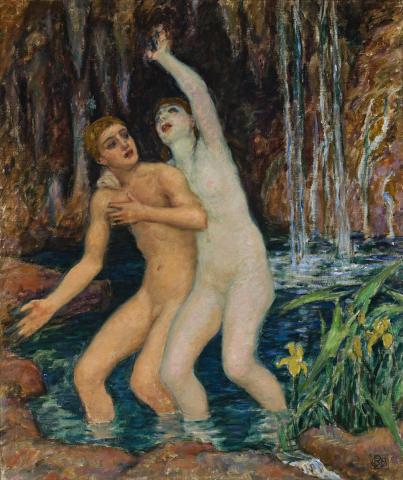THE NYMPH OF SALMACIS, c.1919
RUPERT BUNNY
oil on canvas
56.0 x 46.0 cm
signed lower right with monogram: RCWB
inscribed verso: The Nymph of Salmakis [sic] / R C W Bunny
Dr Ewan Murray-Will, Sydney
Collection of Lex Aitken and Alfredo (Bouret) Gonzalez, Sydney
Exposition Rupert Bunny: Tableaux, Galleries Georges Petit, Paris, 2–15 May 1922, cat. 13 (as 'La Nymph de Salmacis')
Exhibition of Paintings by Rupert C.W. Bunny, Hogan's Art Gallery, Melbourne, 23 September – 10 October 1936, cat. 14 (as 'The Nymph of Salmakis' [sic])
Autumn Exhibition, Victorian Artists Society, 27 April – 9 May 1937, cat. 67 (as 'The Nymph of Salmakis' [sic])
Turnbull, C., and Buesst, T., The Art of Rupert Bunny, Ure Smith, Sydney, 1948, pl. 41 (illus.), p. 75, (as collection of Dr Ewan Murray-Will)
'... so when their forms met in that clinging embrace the nymph and the boy were no longer two, but a single form, possessed of a dual nature, which could not be called male or female, but seemed to be at once both and neither.'1
Rupert Bunny was well versed in the myths and legends of ancient Greece, learnt from his father as a child. Such was his familiarity that Lucy Swanton, director of the Macquarie Galleries, Sydney, where Bunny exhibited in the 1940s, once told me 'Rather disconcertingly he would speak of the Olympian gods and goddesses, the Greek heroes and their women, as casually and familiarly as of next door neighbours with a reminiscent smile for the charmers and that look of slight distaste for the vengeful and meddling ladies.'2 From his early days in Paris in the late nineteenth-century, through the 1920s and beyond, Bunny drew upon this knowledge to create paintings rich in Symbolist interest and individuality. In 1890, he was the first Australian artist to be awarded an honourable mention by the Société des Artistes Français for his painting Tritons (Art Gallery of New South Wales, Sydney). In 1892 Sea Idyll was purchased by the great benefactor and Bunny patron, Alfred Felton, and given to the National Gallery of Victoria, Melbourne. Years later Bunny returned to his 'mythological decorations', as he then termed them, with paintings that pulsated with colour, rhythm and exotic form. Influenced by Sergei Diaghilev's Ballets Russes, which had a sensational impact on Paris and its artists from its first performances in 1909, Bunny produced a body of paintings and related colour monotypes that many connoisseurs consider his most important and individual contribution to art. Exhibited in Paris at the Galeries Georges Petit in 1922, the paintings included The Rape of Persephone, The Prophetic Nymphs (both National Gallery of Australia, Canberra), Circe and Ulysses (Geelong Art Gallery, Victoria), Courtisanes à la Campagne (National Gallery of Victoria), and The Nymph of Salmacis. They were well received by the Paris critics. Writing for Le Figaro, Arsène Alexandre observed lightly, 'The gods are so little in favour, nowadays, that one is charmed to encounter an artist who deals with them, even treats them with familiarity. Mr Rupert Bunny, whose successes at the Salons have been numerous and long-standing, is one of those daring enough to do so. May the gods of Olympus, and the demi-gods of the earth reward him.'3 When shown in Melbourne in 1937, George Bell described the exhibition as a 'glorious riot of colour'.4
The tale of Salmacis from Ovid's Metamorphoses tells of the nymph who passionately pursued Hermaphroditus, son of Hermes and Aphrodite. Nymph of the fountain where Hermaphroditus bathed, Salmacis embraced him and prayed to the gods that they become one body, the very moment depicted by Bunny. In granting her wish, the gods gave birth to the word 'hermaphrodite'. The waters of Salmacis, near Halicarnassus, were said to have wrought an effeminate change on those who drank from them.
1. Ovid, 'Salmacis and Hermaphroditus', Metamorphoses, Book IV
2. Swanton, L., 'Some personal recollections of Rupert Bunny in the forties', type written manuscript, 24 September 1967, p. 2
3. Alexandre, A., 'La vie artistique " Expositions', Le Figaro, 5 May 1922, p. 2 (I would like to thank Anne Gérard for this reference and Emily Groves for her kind assistance with the translation.)
4. Sun News-Pictorial, Melbourne, 23 September 1936, p. 33
DAVID THOMAS
